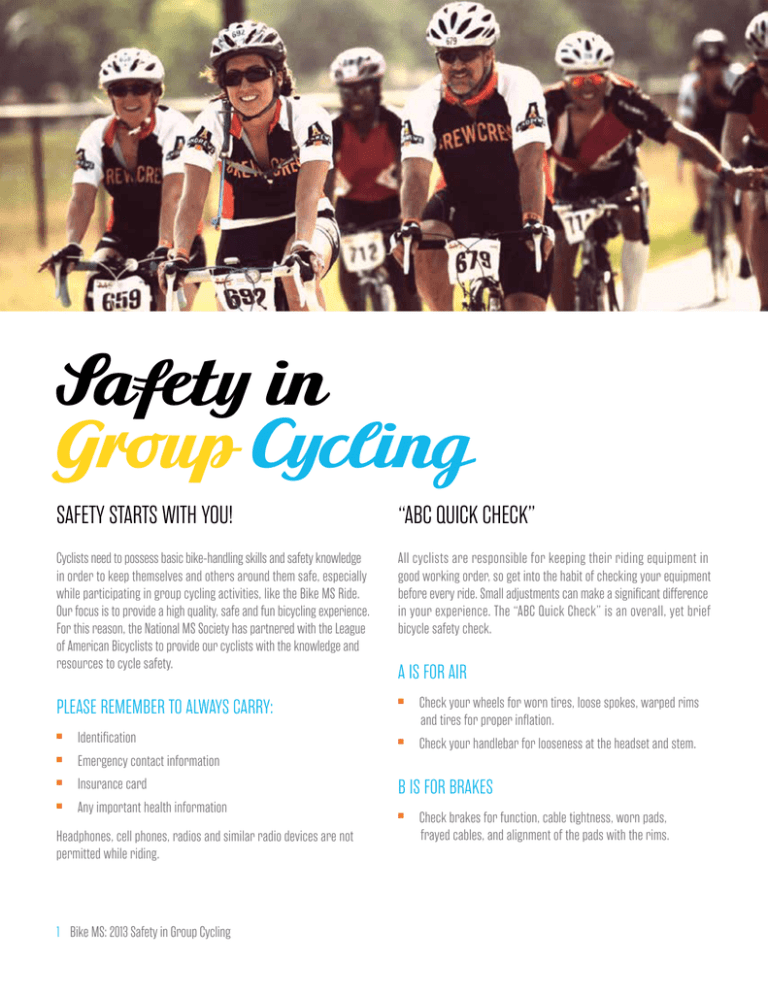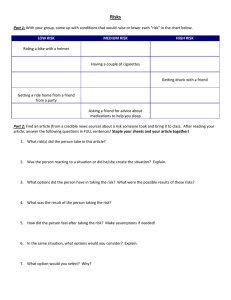Safety StartS with you! “aBC QuiCk CheCk”
advertisement

Safety in Group Cycling Safety Starts with You! “ABC Quick Check” Cyclists need to possess basic bike-handling skills and safety knowledge in order to keep themselves and others around them safe, especially while participating in group cycling activities, like the Bike MS Ride. Our focus is to provide a high quality, safe and fun bicycling experience. For this reason, the National MS Society has partnered with the League of American Bicyclists to provide our cyclists with the knowledge and resources to cycle safety. All cyclists are responsible for keeping their riding equipment in good working order, so get into the habit of checking your equipment before every ride. Small adjustments can make a significant difference in your experience. The “ABC Quick Check” is an overall, yet brief bicycle safety check. Please remember to always carry: n Check your wheels for worn tires, loose spokes, warped rims and tires for proper inflation. n Check your handlebar for looseness at the headset and stem. n Identification n Emergency contact information n Insurance card n Any important health information Headphones, cell phones, radios and similar radio devices are not permitted while riding. 1 Bike MS: 2013 Safety in Group Cycling A is for air B is for brakes n Check brakes for function, cable tightness, worn pads, frayed cables, and alignment of the pads with the rims. C is for cranks, chain & cassette n Safety starts with you. Group mentality is not always safe. Expect to stop at all red lights and stop signs — it is the law! n Check your pedals and cranks for tightness. n n Check for chain looseness and bad links; clean regularly. Lubricate with bicycle chain lube. Each cyclist is responsible for verifying that the intersection is clear. n n Check the derailleur for worn cogs and adjustment. Check that your gears change smoothly. Adjust your safety zone to fit the conditions of the road, weather and traffic. Always plan an escape route. n Never overlap your wheels with another cyclist. n Do not use aerobars in a pack. n Be aware of how weather will affect your bike. Riding in wet conditions requires slower speeds and greater breaking distances. n Be respectful of other riders. Help others when needed. Quick is for quick releases n Check to ensure that the wheels are clamped securely in the drop-outs before each ride. Check n Check your helmet for cracks and make sure it fits properly. n Check your shoes for tight cleats and straps and buckles in good repair. n Make sure your bicycle saddle is the right height and the bolt is tight. Hydration Knowing how to optimize your fluid intake is critical to successfully completing an Bike MS Ride. n One bottle per hour: The rule of thumb is to drink one bottle per hour and supplement with sports drinks at least every third or fourth hour. If you find that you experience extreme fatigue, the inability to recover your energy, or frequent muscle cramps, seek assistance from first aid — you may have the early signs of dehydration. n Seeking medical assistance: If you find that you experience weight gain/bloating with progressive symptoms such as swollen hands and feet, confusion, throbbing headache, dizziness or nausea, please seek assistance from first aid. The Basics of Riding in a Group Group riding takes practice. Riding with other cyclists all around you may cause you to feel trapped. Relax. It is most important to create your own safety zone. This may vary depending on the speed and ability level of the people you are with, so be flexible. Let others know of your anxiety — they may also be new at this. Your responsibility in a pack includes: n Be aware of others around you. n Communicate well in advance. Use gestures in combination with verbal commands. n Ride with your head up. Look down the road; not at the person in front of you. n Maintain control and speed of your bike, even going downhill. n Know your limits. Crashes can occur when inexperienced riders do not have bike-handling skills to make quick decisions in a pack. 2 Bike MS: 2013 Safety in Group Cycling Helmet Smart Head injuries are a special concern for cyclists. Even falling at a slow rate of speed can cause a serious head injury. Helmets must be on your head and strapped while riding in a Bike MS event — no exceptions. Bicycle Laws Helpful Tips All states consider cyclists vehicle operators, and give them the same rights and duties as other drivers. At Bike MS events, our active route support team works to make the ride safe. Here are a few additional suggestions to help keep everyone safe on the ride: n n n n n Know and obey all traffic laws: The golden rule of bicycling in a group is Be Predictable! Stay right: Ride in the right portion of the rightmost lane in the direction you are traveling and leave at least four feet between your handlebars and parked cars or other hazards such as other users. You may move left when passing slower vehicles or preparing for a left turn. Obey all traffic signs and signals: Avoid “following the leader” through traffic signs and signals; you are required to obey all traffic signs and signals, including stopping at red lights and stop signs. Look & signal before you move: Always scan behind you before changing lanes or making turns. A continuous arm signal is required prior to a turn or lane change (unless arm is needed to control the bike) and while stopped waiting to turn. Two at a time: Ride no more than two abreast and do not impede traffic. If a part of the road has been closed and dedicated to “bicycle travel only” you may ride more than two abreast. n Hands on the handlebars: Do not carry anything that prevents keeping one hand on the handlebars. n Pass with care: Do not pass at intersections. 3 Bike MS: 2013 Safety in Group Cycling n Thumbs down for help: SAG vehicles and motorcycle escorts will stop for you if you are off the road, off your bike, and giving a “thumbs down” sign or holding your helmet in the air. n Ride marshal support: A special team of cyclists called Ride Marshals provide support on the rides. They offer minor mechanical help along the route and monitor cycling safety and etiquette. n Rest stop etiquette: All cyclists who enter a rest area must pull over, dismount and move completely away from the road and rest-stop entrance. When exiting, move beyond the rest area and proceed with caution on the right side of the road before merging with faster cyclists. n Passing: Passing others and being passed occurs continuously during the ride. Call out “passing on your left” and allow time for the cyclist being overtaken to move to the right — then pass safely. n Mechanical problems: Examine mechanical problems and change flats completely off the road. If you have a problem you cannot fix yourself, flag down a SAG van and seek a mechanic at the next rest stop. n Be courteous: Bike MS cyclists are privileged to ride on many trails as well as public roads. Be courteous and use no more than half the trail so as not to block the flowm of other users. Know the Lingo Special Situations Group cycling has its own form of communication. The presence of road hazards, directions, and need-to-know information is relayed through the pack of riders by gestures and words. Remember to pass all communication on to the next cyclist behind you in the group. Speak loudly and clearly. Many cyclists find that situations occur when quick thinking and heightened bike-handling skills are required. The following are the most common terms you may hear in group-sponsored rides: n Cars can be scary. Drivers do not know your skill level, and will often not leave room when they pass. Give them the room. In a group, call out “car back” or “car up” and move to the far right in a single file. Be predictable. n Beware of animals. Knowing how to handle animals, specifically dogs, on a bicycle varies depending on the situation. You may want to slow down, outsprint the dog, or yell “stop”, “no” or “go home.” Distracting a dog with a water bottle should only be used when you are not in a pack. Try to keep to one side of the dog. Let others know of your intentions. n Pedestrians, joggers and animals have the right-of-way. Signal to the pack that someone is being overtaken and move to allow room for safe passing. n n On your Left: This means a rider is approaching your left side. Allow room to pass. Car back: This means a car is approaching from the rear. All riders make an effort to move to the right of the road in a single file until the car passes. In most states, the law requires cyclists to ride no more than two abreast. This ensures that traffic will not be impeded, and will make passing easier and safer for the cyclists. n Gravel - Pothole - Sand - Tracks: Each of these messages is to alert the riders behind you of hazardous road conditions. The words are combined with the gesture of pointing to the hazard well in advance. n Flat: This indicates that a rider has suffered a flat tire. Allow enough room for the rider to slow down and move to the right side of the road or trail for repair. Offer assistance if needed. n Slowing: The cyclist in front of you is slowing down. Use caution and prepare to stop. Many cyclists use the palm of their hand toward riders behind them to indicate slowing and stopping. n Stopping: This indicates that a rider ahead is stopping. Do not forget to unclip from your pedals. Headphones, cell phones, radios and similar radio devices are not permitted while riding. 4 Bike MS: 2013 Safety in Group Cycling Here are some suggestions for managing potential obstacles: To visit us online, please go to: bikeMS.org Early and ongoing treatment with an FDA-approved therapy can make a difference for people with multiple sclerosis. Learn about your options by talking to your health care professional and contacting the National MS Society at nationalMSsociety.org or 1-800-FIGHT-MS (344-4867).



